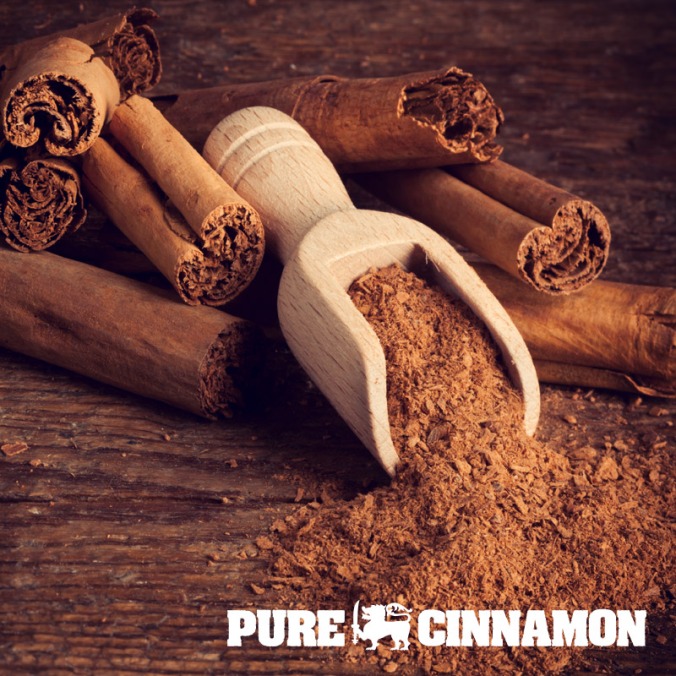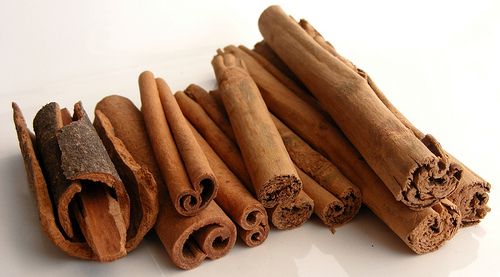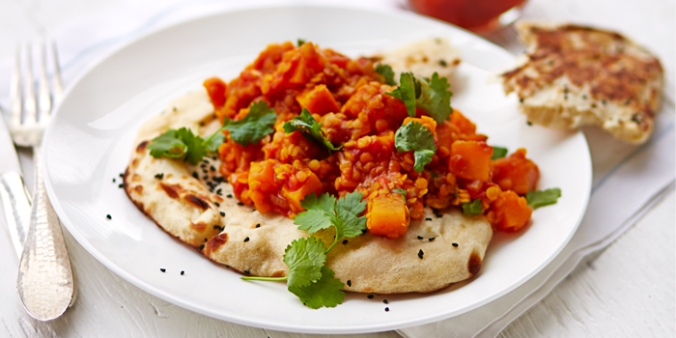Cinnamon is a spice that comes from the branches of wild trees that belong to the genus “Cinnamomum” – native to the Caribbean, South America, and Southeast Asia.
There are two main types of cinnamon:
- Ceylon cinnamon
(Cinnamomum verum), often considered to be “true cinnamon”
(NB: Far less courmarin than Cassia Cinnamon – no risk of liver damage) - Cassia cinnamon or Chinese cinnamon
(Cinnamomum aromaticum), which originates from southern China, is typically less expensive than Ceylon cinnamon.
(NB: Serious risk of liver damage in large quantities)
Due to the fact that Ceylon cinnamon is more expensive, most foods in the USA and Western Europe, including sticky buns, breads and other products use the cheaper Cassia cinnamon (dried Cassia bark). These days cinnamon is regarded as the second most popular spice, next to black pepper, in the United States and Europe.

Cinnamon has been consumed since 2000 BC in Ancient Egypt, where it was very highly prized (almost considered to be a panacea). In medieval times doctors used cinnamon to treat conditions such as coughing, arthritis and sore throats. (This Cinnamon was sourced from the Kandy Kingdom)
Modern research indicates that cinnamon may have some beneficial health properties. Having said that, it is important to recognise that more research and evidence is needed before we can say conclusively that cinnamon has these health benefits.
Possible health benefits of cinnamon

Cinnamon sticks or quills
According to the U.S. National Library of Medicine, Cinnamon can be used to help treat muscle spasms, vomiting, diarrhea, infections, the common cold, loss of appetite, and erectile dysfunction (ED).
Cinnamon may lower blood sugar in people with type 1 or type 2 diabetes, according to Diabetes UK. However high quality research supporting the claim remains scarce.
Fungal infections
According to the National Institutes of Health, cinnamaldehyde – a chemical found in both types of cinnamon – could help fight against bacterial and fungal infections.
Diabetes
Cinnamon may help improve glucose and lipids levels in patients with type 2 diabetes, according to a study published in Diabetics Care.
The study authors concluded that consuming up to 6 grams of cinnamon per day “reduces serum glucose, triglyceride, LDL cholesterol, and total cholesterol in people with type 2 diabetes.” and that “the inclusion of cinnamon in the diet of people with type 2 diabetes will reduce risk factors associated with diabetes and cardiovascular diseases.”
In addition, a certain cinnamon extract can reduce fasting blood sugar levels in patients, researchers reported in the European Journal of Clinical Investigation.

Alzheimer’s disease
Tel Aviv University researchers discovered that cinnamon may help prevent Alzheimer’s disease. According to Prof. Michael Ovadia, of the Department of Zoology at Tel Aviv University, an extract found in cinnamon bark, called CEppt, contains properties that can inhibit the development of the disease.
HIV
A study of Indian medicinal plants revealed that cinnamon may potentially be effective against HIV. According to the study authors, “the most effective extracts against HIV-1 and HIV-2 are respectively Cinnamomum cassia (bark) and Cardiospermum helicacabum (shoot + fruit).”
Multiple Sclerosis
Cinnamon may help stop the destructive process of multiple sclerosis (MS), according to a neurological scientist at Rush University Medical Center. Cinnamon could help eliminate the need to take some expensive and unpleasant drugs.
Lower the negative effects of high fat meals
Penn State researchers revealed that diets rich in cinnamon can help reduce the body’s negative responses to eating high-fat meals.
Treating and healing chronic wounds
Research published in the journal ACS Nano suggests that scientists have found a way to package antimicrobial compounds from peppermint and cinnamon in tiny capsules that can both kill biofilms and actively promote healing.
In this video, Dr. Josh Axe discusses the possible health benefits of cinnamon.
On the next page we look at the nutritional profile of cinnamon and the health risks associated with consuming it (including the fact that cassia cinnamon in particular contains coumarin). We also discuss Tolerable Daily Intakes and how much cinnamon you can safely eat each day.
Nutritional profile of cinnamon
According to the U.S. Department of Agriculture, ten grams of ground cinnamon contains:
- Energy: 24.7 kcal
- Fat: 0.12 g
- Carbohydrates: 8.06 g
- Protein: 0.4 g.
Risks and precautions
Some people who are sensitive to cinnamon may be at an increased risk of liver damage after consuming cinnamon-flavored foods, drinks and food supplements.
This is likely due to the fact that cinnamon contains coumarin, a naturally occurring flavoring substance, which has been linked to liver damage. Cassia cinnamon powder (commonly used in foods in the USA and Western Europe) contains more coumarin than Ceylon cinnamon powder. A 2010 German study found that on average, Cassia cinnamon powder had up to 63 times more coumarin compared to Ceylon cinnamon powder, while Cassia cinnamon sticks contained 18 times more coumarin than Ceylon cinnamon sticks.
How much cinnamon should I eat?
A study carried out in Norway and published in the journal Food and Chemical Toxicology in 2012 suggested establishing a Tolerable Daily Intake (TDI) for coumarin of 0.07mg per kg of bodyweight per day. The researchers commented that by sprinkling cinnamon on oatmeal porridge or drinking cinnamon-based tea regularly, adults and children can very easily exceed this amount.
Based upon the conclusion of this study, if the average weight of an American male is 191 pounds (86.6kg), it could mean a maximum Tolerable Daily Intake of 6mg of coumarin. For an average American female (159 pounds or 72.1kg) it could mean a maximum of 5mg of coumarin per day.
In a document published in 2006, the German Federal Institute for Risk Assessment (BFR) suggested that 1kg of (cassia) cinnamon powder contains between 2.1 and 4.4g of coumarin. If you estimate that powdered cassia cinnamon weighs approximately 0.56 g/cm3, a kilo of cassia cinnamon powder would equal 362.29 teaspoons. This suggests that a single teaspoon of cassia cinnamon powder could contain between 5.8 and 12.1mg of coumarin (which may be above the Tolerable Daily Intake for a smaller individual).
Coumarin In Cinnamon Causes Liver Damage In Some People
Sensitive people who consume cinnamon-flavored foods, drinks and food supplements may have a higher risk of liver damage, researchers from the University of Mississippi, USA, and King Saud University, Riyadh, Saudi Arabia, report in the Journal of Agriculture and Food Chemistry.
Cinnamon is one of the most important flavoring agents in foods and drinks, team leader Ikhlas Khan explained. It is the second most popular spice, next to black pepper, in the United States and Europe.
Ceylon cinnamon, also known as “true cinnamon” (cinnamon verum) is very expensive. Therefore, most foods in the USA and Western Europe, including sticky buns, breads and other products use the cheaper Cassia cinnamon (dried Cassia bark).
Cinnamon comes from the bark of trees and is sold as sticks or powder in the country of origin. Ceylon cinnamon grows in Sri Lanka, Madagascar and the Seychelles, while Cassia cinnamon comes from Indonesia and China. Previous studies have linked coumarin intake to liver damage in a small number of sensitive individuals.
True cinnamon has very little coumarin, unlike Cassia cinnamon. A 2010 German study found that on average, Cassia cinnamon powder had up to 63 times more coumarin compared to Ceylon cinnamon powder, while Cassia cinnamon sticks contained 18 times more than Ceylon cinnamon sticks.
The researchers in this latest study also reported that coumarin, a naturally-occurring substance, may cause liver damage in some sensitive people.

Ceylon cinnamon (left) has much less coumarin than Cassia cinnamon (right)
The authors wrote:
“As found in this study, coumarin was present, sometimes in substantial amounts, in cinnamon-based food supplements and cinnamon-flavored foods.”
According to health officials, consumers cannot tell the difference between Ceylon and Cassia cinnamon in powder form. Cinnamon sticks look different though – Cassia cinnamon sticks consist of a thick layer of rolled bark, while Ceylon cinnamon sticks have thin layers.
Source: medicalnewstoday.com part 1 part 2



